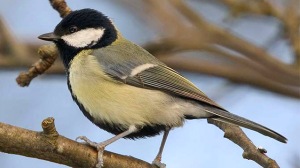
Great Tit
“Great Tits!” shouted the ornithologists from the Max Planck Institute, but it wasn’t risque at all. You can blame Linnaeus for their shout. He named the birds Parus major which is Latin for Great Titmouse. The ornithologists were not being sexist, they were watching Great Tits eat little bats in a cave in Hungary.
They caught the European songbirds pecking at the bats over two winters and concluded that the Great Tits were specifically searching for pipistrelle bats. The bats make a distinctive sound when they are awakening from hibernation, the birds heard the calls, and headed for the bats. To confirm that the birds were attracted to the sounds the scientists recorded the bat sounds and the birds flew to the loudspeaker when the sounds were played back to them.

Pipistrelle Bat photographed by Mnolf
Now there is nothing remarkable about larger birds eating small mammals and small birds. Raptors do it all the time. A Greater Roadrunner ran through our front yard yesterday with a song bird in its mouth.
But not many passerine songbirds have been observed eating mammals. They prefer seed and insects. Besides, most are too small to kill even a tiny mammal like a bat. The scientists advance the hypothesis that the Great Tits will deign to eat bats only during especially hard winters when their regular food is scarce. They also wonder if the birds learned this new foraging behavior through “cultural transmission” which, when you think about it, is probably how your blogger first learned the expression, “Great Tits!”
____________________________
For more, here is the abstract of the study from Biology Letters of the Royal Society. And here are links to news stories from the New York Times and the BBC. The BBC article has a brief, soundless film clip of one the birds pecking away at a bat. For more on Great Tits — not found in North America — look at this page of the Royal Society for the Protection of Birds. You can also listen to their marvelous calls by clicking on the “Listen” icon on the upper left side of the web page.
You can find more about the birds doing a Google search but we don’t recommend it. The search also turns up other “cultural transmissions” that look to be at least “R” rated and have nothing whatever to do with birds.
And don’t forget the vampire finches of the Galapagos.
October 22, 2009 at 7:09 pm |
heard an advertisement for fat finch today on KUNM,
checked out the web site, really like the blog.
However, I’ve seldom run into a better setup line than “For more on Great Tits — not found in North America —”
Thanks and best wishes,
Day Moss
Corona, NM